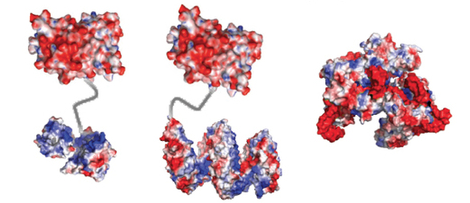DNA Templated Synthesis, CRISPR & Protein Transfection

David Liu just gave a seminar for the Chemical Biology Series. To say that David Liu is accomplished is an understatement: if the guy’s CV was made of lead, you would break your back picking it up. You can check it out on his homepage but suffice it to say, they don’t just give out full Professorships at Harvard and certainly not to the young. Yet there he is, speaking eloquently and looking younger and more dapper than the Postdocs and Grad students in his lab. The kid is good. His talk was about three general subjects: DNA templated synthesis, CRISPR, and protein transfection but the CRISPR and protein transfections stuff sort of melded together.
DNA Templated Synthesis#
His DNA-templated synthesis story was about the creation of a macrocycle library that he used to find inhibitors of the insulin-degradation enzyme ICE. The initial macrocycle hit was a mid-nanomolar inhibitor of ICE but a bit of med-chem optimization led to a ~6nM compound that inhibits ICE by binding near the active site. When pre-adminstered to mice who were challenged with oral glucose, the compound enhanced the uptake of glucose in both healthy and obese mice. Home run! Almost. It turns out that when the glucose is injected, the inhibitor has the opposite effect: glucose levels rise after the administration. Woops! So the story got a bit more confusing: basically ICE also regulates a bunch of other peptides as well as insulin and these include glucagon and amylin which also have roles in energy homeostasis. When glucose is eaten, there is a surge of insulin that is not induced when the glucose is directly injected. The inhibition of ICE therefore actually ends up enhancing the glucagon signal by inhibiting glucagon degradation. How do they know that? They used a glucagon-receptor KO mouse in which all mice experienced enhanced glucose uptake following the administration of oral or injected glucose. Therefore the previously observed affect was glucagon mediated.Very nice.
David also showed how the initial hit was being used to screen for other small molecule hits of ICE. The logic is that if ICE has multiple substrates, and the off-site target is near but not IN the active site, there could be inhibitors that differentially inhibit one set of substrates but not another. Could there be an insulin-specific ICE inhibitor in the works? I don’t know but it would be very exciting.
CRISPR & Protein Transfection#
Although the DNA-templated synthesis story was quite nice, I enjoyed the second part which concerned efforts to allow proteins to cross the membrane and enter the cell. The work David showed is in the context of genome engineering where people want to use Zinc-Finger Nucleases, TALENs, and CRISPR-Cas9 constructs to change mutations in the genome. The issue David is trying to address is twofold: temporal cutting and delivery. Basically, how can you get your re-engineering apparatus to cut only what you want and then get out. One and done is what you want. He highlighted the issue of off-target binding and cutting through a series of studies with the take-home message that there are lots of off-target cuts and the issue is worse if you have a higher concentration of cutter. Therefore, wouldn’t it be great if, instead of putting in a plasmid on a constitutive promoter, you could simply allow only a few of your proteins or protein-RNA complexes into the cell. Theres only a few molecules and they have only a limited time to act, minimizing off-target cutting.
David showed us that highly positively charged proteins could spontaneously cross the outer membrane. If you are charged enough of a protein you can associate with negatively charged headgroups and be endocytosed. The main problem is then getting out of the endosome. So, somewhat paradoxically if you made lipid vessels that were highly cationic, with highly anionic proteins, the lipids could be endocytosed with the protein inside, and then through some mechanism - probably a fusion event, the protein payload could be released into the cell. He demonstrated the introduction of cre-containing proteins into the cell as well as cas9 complexed with a guide RNA. And in the last set of slides (figure 6 in the paper), David showed some pretty pictures of the system working in-vivo in a mouse model of deafness where cas9-gRNAs cross the cell membrane and can successfully correct a mutation. In another slide these mice were able to retain their gain-of-hearing for at least 8 weeks and he believes the 12 week timepoint will also show they have retained the mutation.
This is really phenomenal stuff as it represents the fruition of the cas9-technology for overcoming simple genetic disorders in a lasting way. There are still MANY potential problems but this holds out a lot of hope. Notably, there is still no guarantee of avoiding off-target affects and this is a serious issue as we know that genetic changes in, say, a tumor suppressor, can lead to dire consequences.
All in all a very enjoyable and stimulating talk on the cutting edge of using chemical knowledge to tackle biological questions.